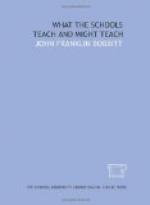1. A list of the unusual words met with is written on the blackboard.
2. Teacher and pupils discuss the meaning of these words; but unfortunately words out of the context often carry no meaning.
3. The words are marked diacritically, and pronounced.
4. Pupils “use the words in sentences.” The pupil frequently has nothing to say that involves the word. It is only given an imitation of a real use by being put into an artificial sentence.
5. The oral reading is begun. One pupil reads a paragraph.
6. With the book removed, the meaning of the paragraph is then reproduced either by the reader or some other pupil. This work is necessarily perfunctory because the pupil knows he is not giving information to anybody. Everybody within hearing already has the meaning fresh in mind from the previous reading. The normal child cannot work up enthusiasm for oral reproduction under such conditions.
7. The paragraph is analyzed into its various elements, and these in turn are discussed in detail.
Such work is not reading. It is analysis. A selection is not read, it is analyzed. The purpose of real reading is to enter into the thought and emotional experience of the writer; not to study the methods by which the author expressed himself. The net result when the work is done as described is to develop a critical consciousness of methods, without helping the children to enter normally and rightly into the experience of the writer. The children of Cleveland need this genuine training in reading.
Reading in the high schools needs very much the same sort of modernization. There are more kinds of literature than classical belles-lettres, and perhaps more important kinds. We would not advocate a reduction of the amount of aesthetic literature. Indeed, the young people of Cleveland need to enter into a far wider range of such literature than is the case at present. But the reading courses in high schools should be built out in ways already recommended for elementary schools.
The training, however, should be mainly in reading and not in analysis. The former is of surpassing importance to all people; the latter is important only to certain specialists. And, what is more, fullness of reading and right ways of reading will accomplish incidentally most of the things aimed at in the analysis.
The following table of the reading outline of the High School of Commerce is a fair sample of what the city is doing. Note how much time is given to the reading and analysis of the few selections covered in four years.
Table 3.—Weeks given to reading of different books in high school of commerce




